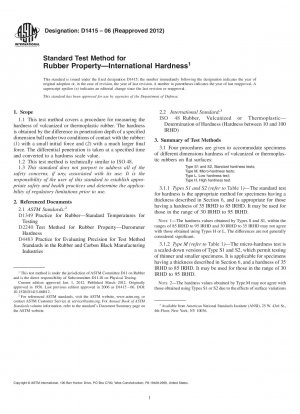ASTM D1415-06(2012)
Standard Test Method for Rubber Propertymdash;International Hardness
- Standard No.
- ASTM D1415-06(2012)
- Release Date
- 2006
- Published By
- American Society for Testing and Materials (ASTM)
- Status
- Replace By
- ASTM D1415-18
- Latest
- ASTM D1415-18
- Scope
The International Hardness test is based on measurement of the penetration of a rigid ball into the rubber specimen under specified conditions. The measured penetration is converted into IRHD, the scale of degrees being so chosen that 0 represents a material having an elastic modulus of zero, and 100 represents a material of infinite elastic modulus.
The scale also fulfills the following conditions over most of the normal range of hardness: one IRHD range represents approximately the same proportionate difference in Young's modulus, and for rubber vulcanizates in the usual range of resilience, readings in IRHD are comparable with those given by a Type A durometer (Test Method D2240) when testing standard specimens.
The term “usual range of resilience” is used to exclude those compounds that have unusually high rates of stress relaxation or deformational hysteresis. For such compounds, differences in the dwell time in the two hardness tests (Test Methods D2240 and D1415) result in differences in hardness values. Readings may not be comparable when testing curved or irregularly shaped test specimens.
For substantially elastic isotropic materials like well-vulcanized natural rubbers, the hardness in IRHD bears a known relation to Young's modulus, although for markedly plastic or anisotropic rubbers the relationship will be less precisely known.
The relation between the difference of penetration and the hardness expressed in IRHD is based on the following:
The relation between penetration and Young's modulus for a perfectly elastic isotropic material:

where: D = known relationship for a perfectly elastic isotropic material, between indentation, R = radium of the ball, mm, F = total indenting force, E = Young's modulus expressed in megapascals, and f = contact force Use of a probit (integrated normal error) curve to relate log10 M and hardness in IRHD, as shown in Fig. 1. This curve is defined as follows:
The value of log10 M corresponding to the midpoint of the curve is equal to 0.364, that is, M = 2.31 MPa or 335 psi.
The maximum slope is equal to 57 IRHD per unit increase in log10 M.

FIG. 1 Point Curve to Relate Log10 M and the Hardness in IRHD1.1 This test method covers a procedure for measuring the hardness of vulcanized or thermoplastic rubber. The hardness is obtained by the difference in penetration depth of a specified dimension ball under two conditions of contact with the rubber: (1) with a s......
ASTM D1415-06(2012) Referenced Document
- ASTM D1349 Standard Practice for Rubber-Standard Temperatures for Testing
- ASTM D2240 Standard Test Method for Properties of Rubber &8212; Durometer Hardness*, 2024-04-19 Update
- ASTM D4483 Standard Practice for Determining Precision for Test Method Standards in the Rubber and Carbon Black Industries
- ISO 48 Rubber, vulcanized or thermoplastic - Determination of hardness (hardness between 10 IRHD and 100 IRHD)
ASTM D1415-06(2012) history
- 2018 ASTM D1415-18 Standard Test Method for Rubber Property—International Hardness
- 2006 ASTM D1415-06(2012) Standard Test Method for Rubber Propertymdash;International Hardness
- 2006 ASTM D1415-06 Standard Test Method for Rubber Property8212;International Hardness
- 2005 ASTM D1415-05 Standard Test Method for Rubber Property8212;International Hardness
- 2004 ASTM D1415-88(2004) Standard Test Method for Rubber Property—International Hardness
- 1988 ASTM D1415-88(1999) Standard Test Method for Rubber Property-International Hardness
- 1994 ASTM D1415-88(1994) Standard Test Method for Rubber Property-International Hardness
- 1968 ASTM D1415-68 Standard Test Method for International Hardness Of Vulcanized Rubber
